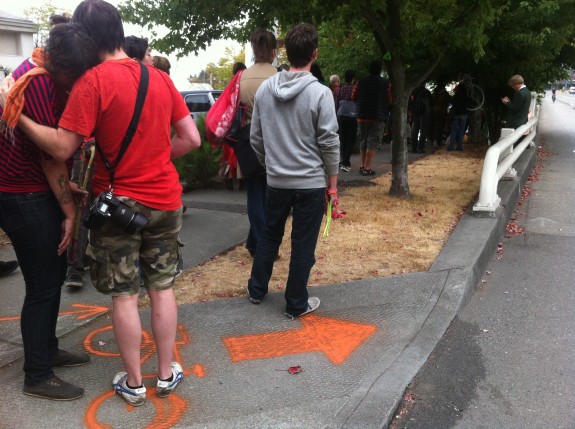
Mike Wang was biking home to his family one evening in July 2011 when a man driving an SUV made a quick left turn and killed him on Dexter Ave. It’s impossible to fill a hole in the world the size of Mike Wang, but through all the tears and pain and anger that followed, something truly powerful shifted in hearts across Seattle.
One month later, Brian Fairbrother was biking on a South Lake Union sidewalk marked as a city trail when he apparently missed the turn onto the Fairview Ave N bridge and crashed down a staircase. I have never seen anything as beautiful as the memorial his community of friends held for him, the response of creative people struggling to understand why Brian had to die.
But when young Robert Townsend was killed while biking deliveries in the U District just one month later, Seattle’s grief and pain and anger finally boiled over. It was too much. People shouldn’t die just for trying to get around our city. Whatever our society thinks we’re getting in return for all these deaths isn’t worth the horrible cost.
Not only can we end traffic violence, we realized, we have to.
That’s why the day after initial returns show the Move Seattle levy passing with a solid margin, I’m sitting at my keyboard trying to type this story through a stream of tears. The path from July 2011 to passing a measure that will invest at least $400 million into an unprecedented effort to end traffic violence — the amazing bloom of genuinely grassroots Seattle Neighborhood Greenways groups in all corners of our city, the Road Safety Summit that crafted our city’s first plan to end deaths and serious injuries, the remake of the Bike Master Plan that lays out the path to crafting safe streets for people of all ages and abilities — was paved by the lives of people who did not need to die.
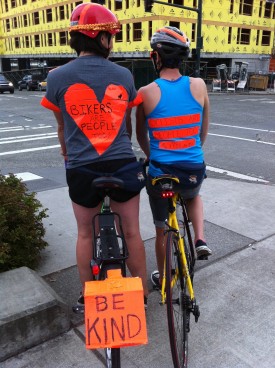
An average of 16 people die every year on Seattle streets. Compared to other big US cities, that horrible total actually makes Seattle one of the safest.
No city in our nation has ever made a financial commitment to safe streets like this. Seattle is forging into uncharted territory. Over the next nine years, we have the responsibility to lead, to prove to cities around the state and the country that the public health menace of traffic deaths and injuries is preventable.
There will be a lot of time to celebrate this win, to thank all the people who worked so hard to get us to this point. There will be a lot of time to look forward, to guide and watchdog these investments. To keep the city honest and make sure politicians don’t cave when vital road safety changes face pushback from people afraid of change.
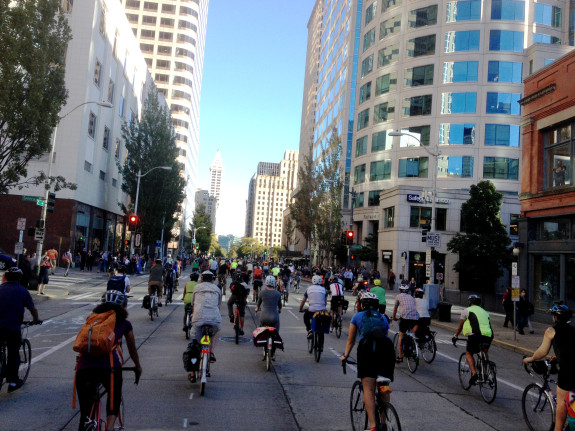
But today, I find myself looking backwards to moments like filling 2nd Ave with a sea of people biking in memory of a young mother and attorney named Sher Kung who had already made a huge impact on the world in her work to help overturn Don’t Ask Don’t Tell. We’ll never know what other important legal wins she would have won because someone in a truck turned into her as she biked to work last year.
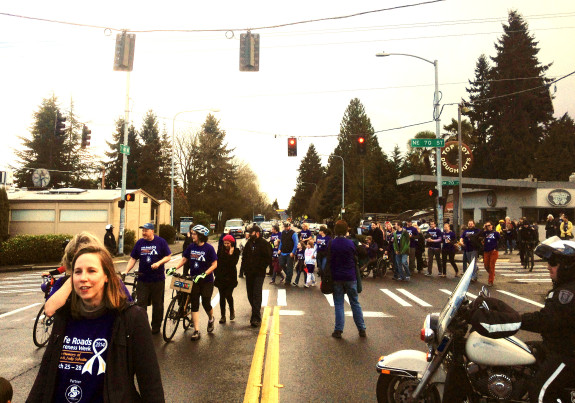
Or marching down NE 75th Street in the rain with a huge crowd of people unable to comprehend the devastating scale of loss and pain felt by a family that, in one horrifying moment, two grandparents are killed and a new mother and child are critically injured by a man driving drunk.
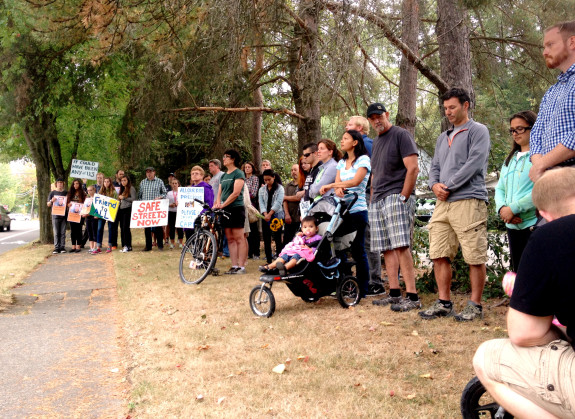
Or shaking Ben Shoop’s hand and listening to him trying to stay strong in the wake of his son Caleb’s death in a Kenmore crosswalk. He’s not asking much, but he just can’t accept that nobody seems to be able to tell him how they are going to stop this from happening to anyone else.
Or witnessing the beautiful struggle of Brandon Blake, a powerfully inspiring man trying to come to terms with his life as a survivor of a traumatic brain injury.
Or the sound forever playing in my head as memorial riders biking past Mike Wang’s wife, daughter and father followed his family’s wishes by calling out, “Wang!” It was a timid cry from dozens of voices choking back tears together.
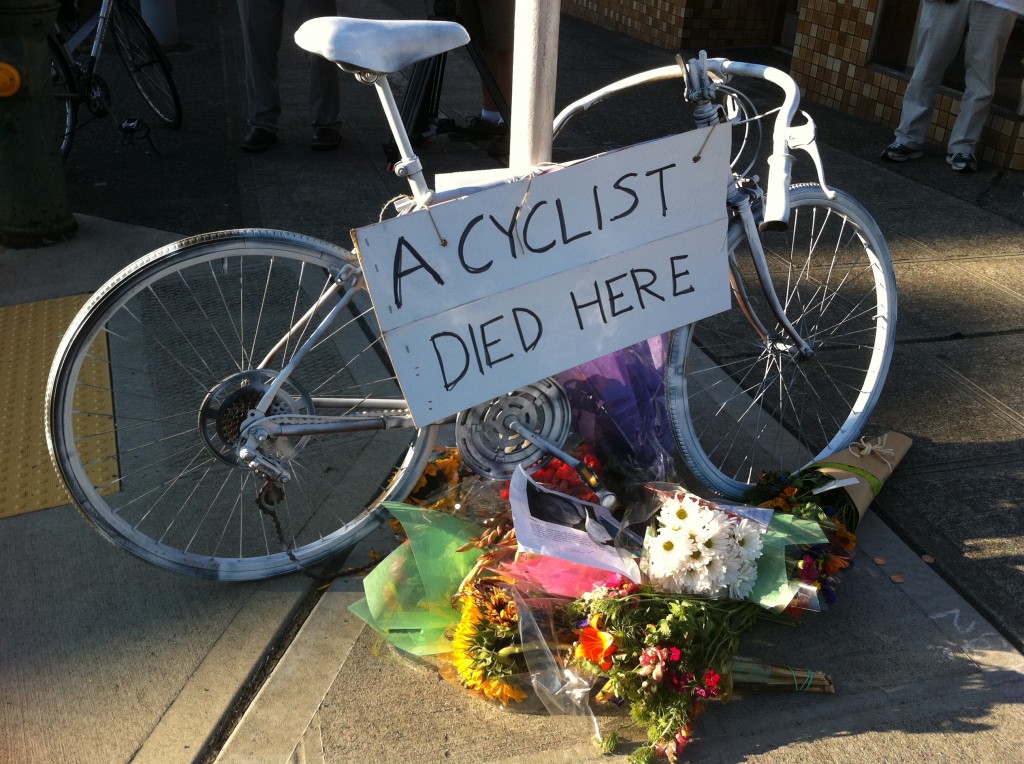








Comments
31 responses to “The true cost of Move Seattle”
Actually, the path forward has been charted by MassDOT. See their new Separated Bike Lane Design and Planning Guide. It just hit the press a few hours ago. This is the kind of design brilliance we need to fast track into our designs right now. It’s going to take grassroots support to evolve our collective design thinking at internet speed. https://www.massdot.state.ma.us/highway/DoingBusinessWithUs/ManualsPublicationsForms/SeparatedBikeLanePlanningDesignGuide.aspx
The new MassDOT guide is light-years ahead of SDOT’s current understanding of cycletracks and separated bike lanes.
It’s hard enough to get SDOT to abide by current minimal standards, they’re much too willing to compromise below minimum standards, e.g. the narrow, slow design for Westlake would never survive MassDOT’s minimum standards.
If the city adopts something like MassDOT’s new guide, it’s going to require a major cultural shift at SDOT to see those standards actually implemented.
How does the community drive that culture change?
The 2014 BMP Update included a binding City Council mandate to meet or exceed both standards and guidance from national, state, and local design manuals, but that’s still just ink on paper, it’s not something SDOT is taking seriously — they cherry-pick the lowest standard, cite that, and ignore tougher standards and guidance.
If making it official city policy isn’t enough to change SDOT practice, what will?
Today’s election results make that a more urgent question — we’re about to start building facilities that will be in place for generations, how do we make sure they at least meet current standards and guidance, rather than locking us into SDOT’s long legacy of substandard facilities?
Personally, I think this comment is so awesome that it warrants a BikePortland-styled “comment of the week” highlight and open discussion. ;-)
a la: http://bikeportland.org/2015/10/30/comment-of-the-week-a-better-way-from-clinton-to-tilikum-167168
Our current path to reform SDOT is through Mayor Murray. He has just seen how the wind is blowing in this city. It’s not cars, forever anymore. And he has the cahjones to make SDOT do it.
Time to remind the mayor what needs to be done with this money. It should appeal to fiscal conservatives as well, because it nearly always pays to do it right the first time.
The vote shows people are willing to spend money on bike infrastructure, but by itself, it doesn’t show people are dissatisfied with substandard bike infrastructure.
SDOT promised not too long ago that they’d never stripe another door zone bike lane. But they still do.
SDOT routinely ignores MUTCD requirements for bicycle facilities (sharrows, bike boxes, two-way turn boxes, bike lane extensions… standard SDOT practice violates FHWA minimum requirements on all of these.)
SDOT claims 10 feet is adequate width for a 2-way cycletrack carrying several hundred riders per hour — their consultant cites London’s much-ridiculed standards in support, ignoring other guides that disagree — CROW would call that width laughably inadequate.
SDOT’s designs routinely use low design speeds that aren’t safe at the speeds ordinary adults actually ride bicycles. That doesn’t just make facilities uncomfortable for fast riders, it makes facilities dangerous for the slower users that fast riders are passing or hitting. The BMP Update would appear to say SDOT must meet or exceed state standards and guidelines, generally a 20 mph design speed for bicycle facilities beside streets. But are they?
The 2014 BMP Update isn’t self-enforcing — now that there’s money for facilities, people need to be contacting their City Council members and asking why the Council isn’t demanding that SDOT comply with adopted policy.
I cannot applaud this comment enough (except that I’d applaud even harder for your below explanation of all the standards SDOT ignores).
I was all set to vote against Prop 1, then at the last minute, I changed my mind. On the way to drop off my ballot at the Ballard Library, I rode the horribly designed Missing Link “Band-Aid” and considered ripping my ballot open to change my vote to NO.
I also want to know what Tom and readers of this blog, and everyone who voted yes, plans to do to put pressure on SDOT to actually build facilities that work. As Josh mentioned, the national standards are routinely ignored in Seattle. Building infrastructure does not equal safety in biking. Words on paper do not equal safety in biking. We’re effectively pricing people out of their homes with these huge increases in property tax, so I would hope that we are all planning to work really hard to make sure this money is used effectively and correctly.
We need to keep up the pressure, it’s that simple. Construction detours for bike lanes and sidewalks need to be a priority. Advancing the latest proven bike lane (and intersection) designs must be something SDOT features. They need to take advantage of maintenance projects to radically lower the cost of bike and walking installations.
An informed and engaged citizen group is the way to do that. Fund Seattle Bike (and Transit) Blog, and/or support good local non-profits (Seattle Neighborhood Greenways, Bikeworks, Cascade, Feet First, WA Bikes, etc). Start your own greenway group, or social media/blog that focuses on something important. Show up to open houses to voice your support, or critique a project – and not just bike projects. Transit projects, road repaving projects, housing projects, etc, should all be taking multi-modal transportion and safety into account, with a focus on prioritizing people who walk and bike. Get involved with your local community council board/neighborhood group so that it’s not just comprised of people who value parking spaces over human lives. Write an app or website to highlight infrastructure problems. Make a video showing some piece of bad infrastructure that needs fixing (or fix it yourself). Let Seattle’s City Council, Mayor, SDOT Director, etc know when SDOT is doing something unsafe or unreasonable (or your WA state reps when it’s WSDOT). Be a squeaky wheel.
There’s lots of stuff we should be doing. Even if you don’t have the time/money/energy to do what I listed above, you can still help support those who do. Or maybe there’s something else you can think of that might help?
Great post! Hard to comprehend the win, it will mean so much world class biking and walking infrastructure built over the next several years.
I was biking on Dexter in SLU towards Fremont at 5PM the other day and I thought I was in Amsterdam for minute. I hope to see many more packs of biking and walking commuters soon. Very cool!
While changes made to 61st Ave after Caleb Shoop’s unfortunate death have improved the roadway, they are far from complete because the new bike lane does not extend south to 181st Street.
What this means for us cyclists, is that some a$$hats that pass slow traffic on the right are endangering northbound cyclists legally using the roadway.
Who has worked on this issue? Besides contacting City of Kenmore to plead for this change, I want to make contact with others to lobby hard for this change.
Thanks in advance
Michael
I see you are in contact with the City of Kenmore, I’d like to offer my assitance, who are talking to there?
I would like to know who to contact at Kenmore that can turn this idea into an approved, budgeted action scheduled by Public Works to be completed. The names I have are
Leslie Harris Management Analyst / Public Information Officer
Kristen Overleese Public Works Director
Brett Schock Traffic Engineer
and how does one contact the Pedestrian Safety Committee?
If I may make a suggestion, don’t work your way up the chain from the bottom. Start at the top and let them delegate down.
Contact every member of the City Council with a brief, clear description of the problem and the solution. Ask them when (not if, but when) they believe it can be fixed.
Council members have ultimate authority over what becomes a budgeted item. They keep their seats by oiling squeaky wheels. They know the internal workings of the city better than you ever will — they can’t order anyone to fix anything, but they can refer constituent complaints to department heads who know that Council approves their budget.
BTW, The adoption of “safe streets for kids walking/bicycling to school” is the trigger. It’s not that it’s safe to commute, or ride to the grocery store that hits people’s nerve, it’s that people remember riding to school as a kid and why isn’t that possible now.
Whoever came up with this slogan deserves more than a beer from me, and I’ll buy if they contact me.
Maybe I could qualify for that beer? http://seattlegreenways.org/blog/2015/04/24/move-seattle-kids/
Yes, Kathy needs a beer over here!
Thank you Tom for covering these events and being a voice for us so well all this time.
Thanks for this writeup, Tom. Your coverage of cyclists and their friends and families and memorials, and keeping the biking community’s eyes on the big picture is skillful and appreciated. I hadn’t connected the passage of the levy to those losses, but I’m glad you made the connection. I ride past the places where Mike Wang and my friend Sher died nearly every day, and the streets look so different now than they did when they were killed. I can’t wait to see where we are when we spend this levy money.
I knew Robert Storm Townsend. Every messenger and bike mechanic I know haa been hit by cars or busses. I was hit so bad by a driver who left me in the road I lost my job, my savings and almost my home. I live in Portland now and was hit yesterday. All these things to make streets safer will not help until drivers realize they are in control of a weapon when used wrong.
[…] never believe what’s blocking the bike lane in Louisville, via Broken Sidewalk. And Seattle Bike Blog says that voter approval of the “Move Seattle” transportation levy will lead to an […]
Congrats. Meanwhile, in San Francisco, the forces of the status quo and NIMBY have ensured that we will continue to kill bicyclists at an ever-increasing rate, because it is much more important to ensure that we will not lose 5% of our parking spaces than it is to actually not kill people.
One of the basic elements in Move Seattle is repaving city streets. Some might think this is just a sop for cars, but bicycles and buses also travel on that pavement. I’m sure we could get more people on bicycles if they had fewer potholes to dodge (streets with good pavement get very few potholes).
Not just dodging potholes, either — about the most disgusting commute experience is being drenched with spray when a car next to you hits a puddle full of whatever’s been running down the street.
I don’t mind rain, it’s wet but clean, a little supplemental shower never hurt anyone. But a bucketful of road slop sprayed *up* under my rain gear…
On rainy days, I actually change my commute route to steeper streets with less ponding in bad pavement.
How quickly they forget: http://www.seattlebikeblog.com/2014/12/18/if-holman-road-is-a-complete-street-then-that-term-has-lost-all-meaning/
Too bad it’s a property tax measure–needs to go statewide and funded by an increase in the state’s piss-ant little gasoline tax. Not in Tim Eyman’s lifetime, I guess.
Meh. Our property taxes aren’t that high… we just have to think about them a lot because of all the various, random, tiny property tax levies we have to vote on. Property taxes are levied against a form of accumulated wealth; if you’re trying to tax people according to their ability to pay you need to tax according to income and accumulated wealth. So while a combination of income taxes and more broad-based taxes on accumulated wealth would be better than pure property taxes from a general fairness perspective, consumption taxes (like the gas tax) hit poorer people much harder in a much more general way. The property tax is the most equitable form of taxation local governments have available in Washington.
Gas taxes have the advantage of discouraging gas-burning, and while comprehensive pollution taxes would be better (especially for carbon, possibly taking the form of the market price for carbon in a cap-and-trade scheme) direct taxes on gas and other fossil fuels are the closest thing to that we currently have. It would be good if we did more with gas taxes. That said, a fast and large increase in the gas tax would have a big impact on the suburban and rural working class — a bigger impact on more people than any property tax yet conceived. That’s why serious cap-and-trade and carbon tax proposals are introduced gradually and with lead-in time.
Tom, thank you so much for writing such a human piece. The true cost is much too high, and we will likely continue to pay it.
Ditto
This reminds me of part of a pro-levy writeup I did towards the end of the campaign: http://on.fb.me/1SuIsWI
[…] from the school district How many Kentuckians will die if Matt Bevin snatches away ObamaCare? The true cost of Move Seattle (“traffic violence”) Do Not Treat Difficult Students Like […]
[…] It was the product of so many acts big and small by so many people over so many years. And as I wrote the day after it passed, the huge increases in safe streets funding came at an immense cost: The […]
[…] Fuculoro, the publisher of Seattle Bike Blog and a vocal supporter of Move Seattle, wrote a moving article Wednesday that traced the history of Seattle’s remarkable new direction back to a series of […]